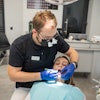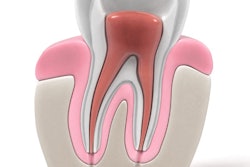
SAN FRANCISCO - Researchers evaluated and compared various anesthetics for endodontic treatments, and they presented their findings at a session of the 2016 American Association of Endodontists (AAE) meeting in San Francisco on April 7. Topics included comparisons of articaine and lidocaine and using supplemental intraseptal injections when nerve blocks fail.
Anesthetic efficacy
The first study, by Tera Bonar, DMD, and colleagues at the Ohio State University (OSU) College of Dentistry, was a prospective comparison of the anesthetic efficacy of primary intraseptal injections of articaine and lidocaine, administered with a computer-controlled local anesthetic delivery system in asymptomatic mandibular first molars. The study included 100 patients at the school's dental clinic who received intraseptal injections of 1.4 mL of 4% articaine and 2% lidocaine, both with 1:100,000 epinephrine, at two separate appointments.
Injections were given in the interdental papillae, mesial (0.7 mL) and distal (0.7 mL) to the first molar. An electric pulp tester was used to test for pulpal anesthesia. Injection pain, postoperative pain, and heart rate also were evaluated.
No significant difference
Anesthetic success rates for the mandibular first molar were 35% for articaine and 28% for lidocaine, with no statistically significant difference (p > 0.05). The study found no significant differences between articaine and lidocaine for injection pain.
All injection pain ratings were in the mild pain category, except for mesial needle insertion pain, which was in the moderate pain category. The researchers found no significant differences between articaine and lidocaine for changes in heart rate. Postoperative pain decreased each day with no significant differences between the solutions.
The anesthetic efficacy of articaine was not significantly better than lidocaine for primary intraseptal anesthesia of the mandibular first molar. Primary intraseptal injection does not achieve high enough success rates of pulpal anesthesia to support its use, the study authors concluded.
Anesthesia after nerve block failure
In a second study presented at the session, Stephen Webster Jr., DDS, and colleagues also from the OSU College of Dentistry performed a prospective analysis of the anesthetic efficacy of the supplemental intraseptal technique in mandibular posterior teeth diagnosed with symptomatic irreversible pulpitis when the conventional inferior alveolar nerve block (IANB) fails.
The goal was accessing the tooth without pain or with mild pain to patients.
The study analyzed 100 patients at the school's dental clinic who were experiencing moderate to severe pain with a symptomatic irreversible pulpitis in a mandibular posterior tooth. Most of the teeth involved were first or second molars.
Following profound lip numbness after the administration of the conventional nerve block, patients still experiencing moderate to severe pain during treatment were given mesial and distal intraseptal injections, each with 0.7 mL of 4% articaine with 1:100,000 epinephrine, using a computer-controlled local anesthetic delivery system.
Low levels of success?
The goal was accessing the tooth without pain or with mild pain to patients. Initial success with the IAN block was achieved in 25% of patients. The intraseptal injection was administered to 73 patients with moderate to severe pain following profound lip numbness with the IANB.
The intraseptal injection provided success in 21 out of 73 (29%) of patients. The supplemental intraseptal injection achieved profound pulpal anesthesia in 29% of patients when the IANB failed.
This low level of success did not provide predictable levels of anesthesia for patients requiring emergency endodontic treatment for symptomatic irreversible pulpitis in a mandibular posterior tooth, according to the researchers.



















